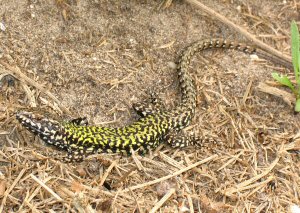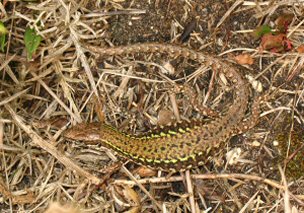
The Wall Lizard - Podarcis muralisIntroductionThere are many different sub-species of Wall Lizard which, between them, are widespread throughout Europe. They are even found in the UK although almost all the colonies are known to be introductions and even the one or two whose origins are unknown are unlikely to be native. The animals I keep originated from a single UK colony in the late 80s. At a superficial glance Wall Lizards can sometimes be mistaken for Viviparous Lizards. They are, however, a more slender lizard and the head is longer and more pointed. They do grow somewhat larger than the Viviparous Lizard and can approach the length of a large Sand Lizard. They do not, however, come anywhere near the bulk of these animals. Markings and colouration are often very similar to the Viviparous Lizard but they will often have a row of blue scales along the lower flank (almost on the belly) and the tail usually has patterning carried right round it in whorls unlike the former species. Green animals are quite common, especially in males, and where this is found it is generally a much brighter green than occasionally seen in Viviparous Lizards. As their name suggests, their favoured habitat is walls, or similar naturally occurring rock formations where they take advantage of nooks and crannies in the wall or rock to conceal themselves. They are rather shy and extremely fast moving lizards although where they are used to people seeing them as with one or two of the introductions in the Bournemouth area it is possible to watch them quite closely. This is a European Protected Species.
AccommodationThis species can be kept in an indoor vivarium although it is unlikely to realise anything like its full life span. In addition, being extremely agile, lively and often highly strung they need a disproportionately large vivarium. Last, but not least, males in particular are extremely aggressively territorial as are some females. This even shows in their relationship with other species, even those considerably larger than them. Quite simply you should not rely on these animals sharing a vivarium with any others. Consequently, an absolute minimum of a 1 metre by 0.5 metre vivarium would be required for a single pair.Having said this, some people have successfully maintained larger groups in such vivaria. Certainly it seems that having a group together, especially if reared from young together tends to inhibit their typically aggressive territorial behaviour. It must also be said that this species (together with some other Podarcis and similar Lacertids) can make a beautiful display. A wide and tall vivarium, yet with minimal depth, with a stone wall emulated at its back together with artificial vegetation can rival a fish tank for both beauty and behaviour. The name "Wall lizard" is well descriptive of their habitat. Accordingly the terrarium benefits from rocks, or similar, heaped to provide basking and hiding areas. But, you must ensure that the rocks are well fixed and cannot move thereby crushing the lizards. They are fairly tolerant in respect of soil types and sand, grit, gravel or one of the available artificial compounds are all suitable. In fact, the conventional semi-desert setup suits them down to the ground. A water bowl and a light spray in the morning are necessary to take care of their moisture requirements. UV lighting and a substantial temperature gradient are essential to their well-being. The ambient temperature during the summer should be around 25-30ºC during daytime in the summer with a basking hotspot of around 40ºC. At night the temperature should drop to around 15ºC. During the winter, the overall temperature should be held between 5 and 10º. Should the temperature grow warmer than this, since they typically brumate rather than hibernate they will become active but can happily be cooled down again until Spring. To see these animals at their best an outdoor vivarium is far better. A small garden frame will again support a pair and numbers can be increased as space permits. Excellent drainage is essential as they do not happily tolerate excess humidity. Just as with indoor vivaria, they will do best if provided with a rock pile, or even a wall in which they can hide and on which they bask. They can and will live happily throughout most of the UK in such an enclosure for many years. Only in the coldest and wettest areas are they likely to need additional shelter such as might be provided by keeping them in a greenhouse. BreedingMating starts during the Spring and is typical of lacertids (see our Breeding pages). After a period of 4-6 weeks the female will be extremely fat although individual egg bulges are seldom visible. She will usually dig one or two test burrows in a warm spot before choosing where to lay the eggs but these animals cannot be relied upon to do this or to use available sand. Eggs may be laid in sand, under, rocks or even under vegetation and can often be very difficult to find. 2 to 6 eggs are laid typically and, ideally, these should be found and incubated artificially although unlike most captive species there is a good chance of these incubating naturally if not found.. When the young hatch, they will usually start feeding within 24 hours of birth. Like P. sicula, both first and second clutches, if not found, will generally incubate and hatch out naturally in the south of England. This species will mate and lay repeated clutches
throughout much of the Spring and Summer. I have often
had 3 clutches a year and on at least one occasion a
female has produced 6. FeedingThese are primarily insectivorous lizards and should be fed a suitable range of insects. When fully grown they can handle any of the small invertebrates listed in our live foods page. These should be gut loaded and dusted with a suitable multivitamin powder. If you are fortunate enough to have them breed then at this stage they require extremely small insects - "micro" crickets are good as are buffalo worms or other similar sized prey. Gut-loading and vitamin dusting are essential. Obtaining your animalsThis is now a "European Protected Species". In essence this means that any wild caught ones are probably illegal. There may be an exception in terms of the ones found in the UK as they are not native but this is not currently clear under the UK legislation implementing Annex IV of the Habitats Directive. A few enthusiasts do keep and breed this species and the even more anti-social but very beautiful Ruin Lizard (Podarcis siculus)and it is probably only through them that you could obtain animals. Always ensure that you obtain suitable certification of their captive bred status. Occasionally other Podarcis and similar species such as Rock Lizards (Darevskia spp) become available. These are similar in their requirements. |
||||||
|
Next - Podarcis sicula - The Italian Wall Lizard or Ruin Lizard.
|

